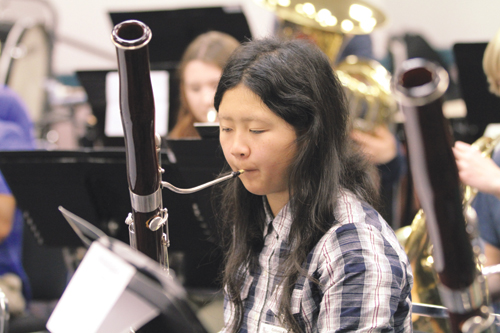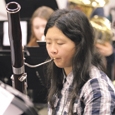
The bassoon’s role in bands is often misunderstood. Attitudes against the bassoon usually stem from one of several prevailing misconceptions regarding the instrument. Below are some of the most common misunderstandings about the bassoon, along with recommendations that should help music educators in making their student bassoonists a successful part of the program.
Size
The most common objection to starting a student on the bassoon is usually about size. Some of this is based in fact. It is true that the bassoon requires a wider finger span than other wind instruments, because the tone holes must be distributed at a relatively wide distance and must also be angled. The width and weight distribution of the instrument also present some challenges.
With the right tools and guidance, however, people of all shapes, sizes, weights, and heights can play the bassoon. Even a smaller-than-average student should be able to play the instrument successfully.
The bassoon, much like the clarinet, requires its tone holes to be covered completely by the pads of the fingers. To do this, proper positioning of the hand and body position is imperative. Often people mistakenly believe there is an issue with hand size when the real issue is a problem with the physical approach to the instrument. Correct bassoon playing and hand position should be confirmed by examining four physical elements.
First, the seat strap (to be used during seated playing) should not be too far back on the chair. Placing the strap too far back will affect the angle of the instrument and cause problems with the arm, wrist, and ultimately, finger placement, all of which should be natural and comfortable. For proper positioning, the seat strap should be placed from one to three inches back on the chair and should be visible between the legs of the player.
Second, the left hand should support the weight of the instrument at the base of the index finger (i.e. at the knuckle that connects the finger to the hand). Supporting the instrument in this way may take students a while to master. A common difficulty is that the forward inclination of the instrument gives a sensation of instability, and sometimes beginning players try to use other measures to prevent the instrument from falling. Some students, for example, may anchor their pinkies or thumbs against the body of the instrument. This should be avoided, because it will only create tension and limit dexterity.
Third, proper position requires the right hand to form a C shape that is not collapsed against the side of the bore. This too can feel slightly unnatural to beginners, whose natural tendency will be to bend at the knuckle in order to rest their palm against the side of the bassoon. To help with proper positioning of the right hand, students may make use of a crutch, which is standard on most bassoons. This hand positioning device may be used bulb-up or bulb-down, depending on the student’s size and comfort.
Fourth, the bocal does not need to be parallel to the whisper key pad, but the tone hole in the bocal must be covered when the whisper key is engaged. It may be necessary for the bocal to be slightly angled in relation to the whisper key pad in order to ensure a natural wrist position.
For students who cannot span the distance to reach all tone holes, even with proper positioning, many student bassoons now have a plateau key, or an extended key in place of the left ring finger tone hole. This mechanism makes the finger span of the bassoon similar to that of any other woodwind instrument, which should prevent size considerations from discouraging any students away from the bassoon.
Volume
It is true that the bassoon does not have the decibel capacity of some other instruments, due to the predominance of overtones in the bassoon’s sound. These overtones give the bassoon its warm and rich tone quality. This is one of the bassoon’s best attributes as an ensemble instrument, even though it may not offer the strong presence of an instrument like the oboe or trumpet. The bassoon’s overtones and tone quality give it the capacity to blend well with other instruments in large and small ensemble settings. The bassoons complement and equal out the more penetrating sounds of other instruments, creating balance within the ensemble.
Ensemble directors should strive to understand the role of the bassoon and appreciate its value to their various ensembles. Throughout music history, composers have made good use the bassoon in bass, tenor, and alto roles. Even in the band setting, where bassoon parts tend to be doubled by other instruments, the bassoon has the potential to make significant contributions. Even when the bassoon is not itself a melodic force in and of itself, it plays an important role in making its collaborators sound better.
Directors should also recognize that in music where the bassoon does take on a solo role, the player should never force the sound. The optimum volume for the bassoon is reached when it is allowed to resonate freely. A tense and forceful air stream will only serve to make the pitch sharp, not to increase volume.
Difficulty
Several years ago I was hired to teach private lessons to a girl who had recently started the bassoon in her junior high beginning band class. The student showed up at her first lesson feeling very frustrated and disappointed with herself. Several weeks into the school year, this student had watched as her classmates acclimated to their instruments with ease, while she struggled with seemingly the simplest of tasks. Many attribute this scenario to a simple explanation: that the bassoon is simply too complicated an instrument for a beginning student.
Every instrument has challenges that can make it seem too hard. Regarding the bassoon, most people cite the number of thumb keys (13), and the number of fingers used (up to 10) as the major challenges.
These challenges are difficult, to be sure, but the greater difficulty encountered by beginning bassoonists, compared to their peers in the band, is often a matter of repertoire. Most beginning band players grow accustomed to the instrument and gain confidence by playing ensemble works of gradually increasing difficulty. Usually the beginning band works will be in the key of Bb major. This is a sensible choice for the ensemble as a whole, because Bb is an easy key for most wind instruments. On the bassoon, however, Bb can be a challenging key, particularly for the beginner. It contains forked, vented/flicked, and half-holed fingerings. The lower octave, in particular, contains pitches that employ thumb/pinky combinations that can be difficult for the beginner, who needs time to execute these demands successfully. For this reason it is often best for beginning bassoon students to work on pieces in C major, at least during solo practice.
The beginning junior high student I worked with years ago grew discouraged in the band setting, where her part was doubled by many other instruments. Parts that others could zip through with ease were difficult for her to play, and she deduced this to be a reflection of her abilities. After we worked on bassoon-specific repertoire and technique, however, this student quickly flourished and caught up to her classmates.
Directors and students should understand that what is beginning material for most instruments will often be at a much higher difficulty level on the bassoon. To develop fundamental skills on the bassoon, students should work on bassoon-specific beginning repertoire to supplement their experience playing large ensemble repertoire. Music especially designed for bassoon beginners not only will help in developing fundamental skills, but it also will help in building confidence and morale. (One set of beginning etudes that I recommend is the Weissenborn Method for Bassoon.)
Manufactured Reeds
Unless your bassoon students take private lessons, most likely they will be playing on store-bought reeds. Both the director and students alike should understand that manufactured reeds are an unfinished product. A manufactured reed is known as a blank, meaning that it just has the reed blades cut and no other finishing is done. Reeds are sold this way because it is assumed that players will want to finish the reed to suit their own preferences. If a manufactured reed blank is played on as if it were a finished product, the sound will likely be wild, buzzy, and resistant with poor response. Neither you nor your student will be satisfied with the sound that results from playing on a manufactured reed as-is.
All bassoonists should play on hand-finished reeds. If the student does not have the opportunity to work with a private instructor who can help with hand finishing their reeds, good finished reeds can easily be obtained online. Woodwind and especially double reed supply companies boast a variety of hand-finished reed options, and they will be happy to help find one that suits your students. Although one might assume that there is an added expense in obtaining a hand-made bassoon reed, there are many fine options that cost equal to or even less than a manufactured blank.
The benefits of playing on a finished reed will be immediately noticeable and worthwhile. As the primary contributor to pitch, tone and response, the importance of the reed to the bassoonist cannot be overstated.
Despite the myths and misconceptions that are sometimes attached to the instrument, the bassoon serves an important purpose in large and small ensembles alike. Any student who is responsible and engaged will have great potential to excel on the instrument, provided that proper assistance is given. I encourage all directors to address the challenges of the bassoon with confidence and to explore how the bassoon can contribute significantly to a successful band program.






